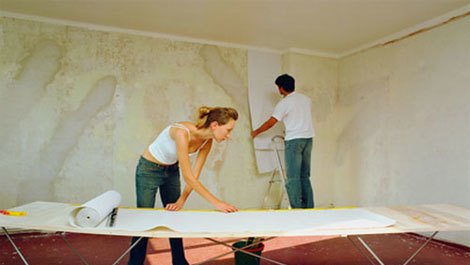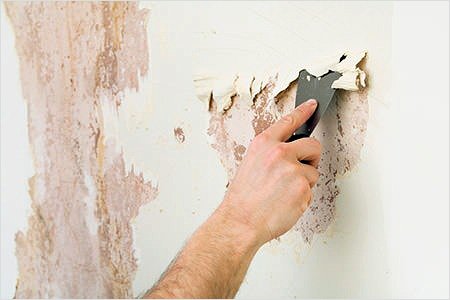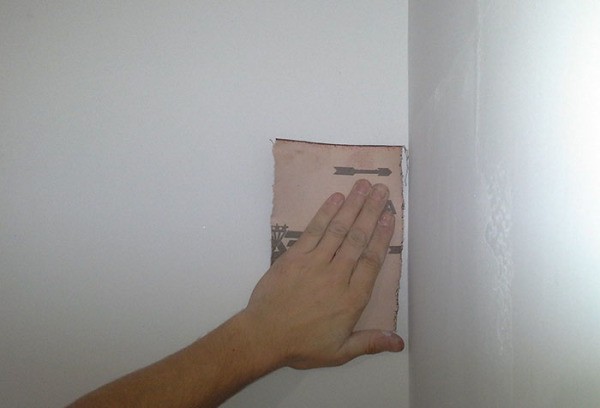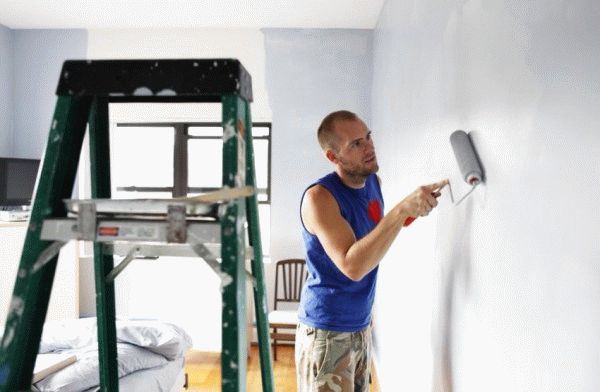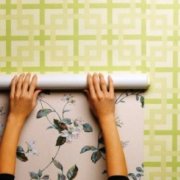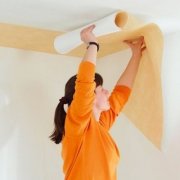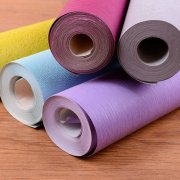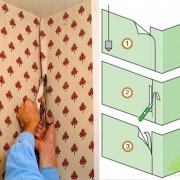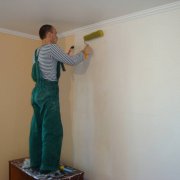Sticking wallpaper on oil paint: how to do it right
How to paste wallpaper on oil paint? This issue is especially important for owners of apartments from the old foundation, where the walls are often painted with oil or enamel paints. Despite a durable and high-quality coating, room repair becomes inevitable over time, which raises the natural question - is it possible to glue wallpaper on oil paint without cleaning it to the very bottom? The answer to this question is offered by this article.
The content of the article
Features of oil paint
Such material is made on the basis of ordinary drying oil, which can be:
- Natural.
- Artificial.
First, the pigment that is most available in the color is mixed, and then the remaining compounds are added. The paint is diluted to the required thickness.
The benefits of these coatings include:
- High strength.
- Durability.
If you want to stick wallpaper on the paint with your own hands, you need to determine its category:
- If the surface of the wall is not shiny, it cannot be wiped off with a wet rag, most likely, water-dispersion paint was used to apply the coating. Soaking it will not work, but removing with a spatula seems possible and not too difficult.
- Whitewash is easier. To determine it, you just need to rub with your hand, on which a white coating should remain. It is not worth gluing the whitewashed wall with chalk or lime, the coating on such a surface will not hold. But if you remove all unnecessary with a wet sponge or brush, the panels will hold quite reliably.
- Enamel and oil paints do not react at all to waterThey have a smooth, shiny surface.
Tip: Do not glue wallpaper on an existing layer of oil paint. But subject to certain surface preparation technologies, this can be done.
How to prepare a surface for a wallpaper sticker with oil paint on it
Before you stick the wallpaper on oil paint, all surfaces must be carefully inspected.
Wherein:
- Places for the presence of cracks, lagging layers, which are often removed together with putty, are determined (seeHow to remove putty from the walls and how much is needed) or plaster. Such defects must not be left.
- Be sure to remove all nails, protruding elements, dismantle the skirting board.
Tip: If after rough preparation half or more of the existing coating has been removed, the surface should be completely cleaned. If the main part of the walls inspires confidence, you can use special preparatory techniques.
- Before you paste the wallpaper on oil paint, you need to sand the wall, as shown in the photo. The adhesion of oil paint to another coating is known to be very poor.
To enhance adhesion, a smooth plane must be made rough.
For this:
- A coarse-grained emery cloth should be walked along all the walls.
- Walls are treated with a deep penetration primer (seeTypes of construction primers and their scope).
- The solution remains to dry for 24 hours.
- The cleaned areas are compared by plastering on a gypsum base (seeGypsum putty: its advantages and problems of use).
- Surfaces are washed with soapy warm water. This solution will wash off the grease, which will allow the paper to stick better.
- To enhance the properties of the composition in the wallpaper glue, you need to add a small part of the PVA glue.
Tip: Before stickering the wall, you need to smear the wall with a small layer of PVA glue diluted with water, give it a little time to “seize”, but, without waiting for it to dry completely, start pasting.
How to choose the right glue
Before gluing the wallpaper, the glue is selected correctly.
It is better to purchase it for wallpaper with a large mass:
- Even for thin, single-layer material, a mixture intended for vinyl wallpaper is taken. It can be:
- Bustilate;
- Moment;
- Methylane
- If the price suits you, it is best to purchase PVA glue. The composition applies:
- in pure form;
- diluted with water in a ratio of 1: 1.
How to prime surfaces
The main steps in preparing the surface should be aimed at improving the adhesion of paper wallpaper on the wall, which consists in eliminating the ability of oil paints to absorb substances poorly.
Work instruction:
- Concrete contact soil or quartzite is purchased.
- The walls are washed and dried.
- A composition is applied with a layer thickness of approximately 4 millimeters.
- After drying, the surfaces are puttyed with ordinary putty.
- The dried layer is again covered with a primer.
- Selected wallpapers are glued to the dried walls.
- The primer can be made independently from accessible and not expensive materials, which can be: PVA glue and
- alabaster.
For this:
- water is poured into the container;
- a little alabaster is added there, with constant stirring of the mixture;
- after the composition has reached the consistency of sour cream, PVA glue is added, while the ratio of the compositions is taken: three water for one part of the glue.
- Well-washed walls are smeared with a home-made emulsion and left to dry.
Some Wallpaper Sticker Tips
- To increase the strength of gluing wallpaper, cover with glue need canvas and walls.
- Drafts should not be allowed during the work, and after its completion. Windows and doors are tightly closed until the walls are completely dry.
- Do not stick the wallpaper in the heat or cold, in the presence of high humidity.
How to glue wallpaper on oil paint
After surface preparation, acquisition or preparation of glue, wall pasting is performed.
For this:
- The height of the surface from floor to ceiling is measured.
- The length of the wall is measured and the number of required strips is calculated.
- The required number of strips is cut, the length of each is taken more by one centimeter.
- According to the instructions for the wallpaper, glue is applied. For different wallpapers, a different method of applying glue is used.
- The first sheet adheres correctly. Before gluing it, a line is drawn with a pencil, using the level, stepping back from the near corner to the distance along the width of the wallpaper. This line will allow you to correctly and evenly position the wallpaper on the wall.
- It is necessary to paste over the room from the corner.
- The sheet must be glued from the ceiling, the top joint is leveled and the sheet is pressed against the wall with a rubber roller or plastic spatula.
- The canvas is smoothed from the center of the sheet to its edges.
- The existing folds are smoothed out and the air bubbles under the sheet are removed.
Professionals glue wallpaper on painted walls, without removing the paint is not advised. But if such a decision is made, then it is necessary to correctly prepare the surfaces.
After watching the video, you can find answers to many questions.
